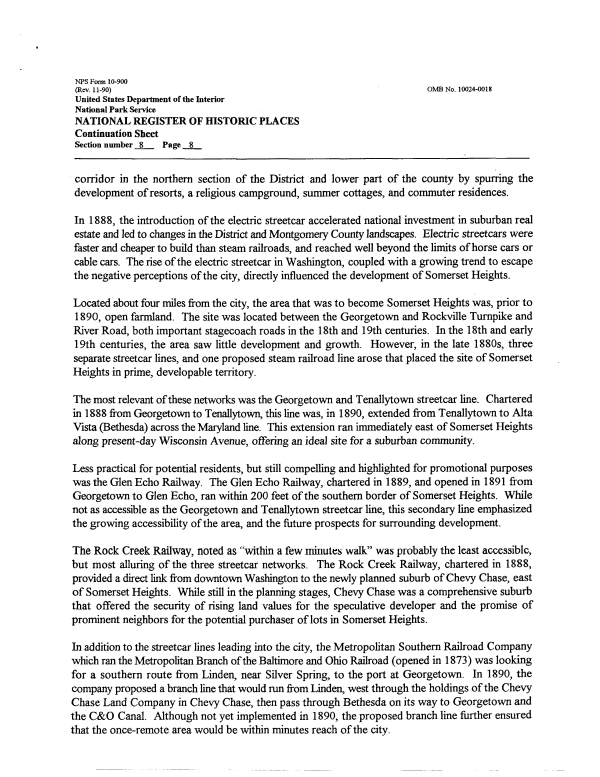 |
||||
|
DEPARTMENT OF HOUSING AND COMMUNITY DEVELOPMENT, MARYLAND HISTORICAL TRUST (Historic Sites Survey) var.d. MSA SE16-5 Image No: se16-5-0234 Enlarge and print image (81K) |
 |
||||
|
DEPARTMENT OF HOUSING AND COMMUNITY DEVELOPMENT, MARYLAND HISTORICAL TRUST (Historic Sites Survey) var.d. MSA SE16-5 Image No: se16-5-0234 Enlarge and print image (81K) |
| NFS Form 10-900 (Rev. 11-90) OMB No. 10024-0018 United States Department of the Interior National Park Service NATIONAL REGISTER OF HISTORIC PLACES Continuation Sheet Section number _8_ Page 8 corridor in the northern section of the District and lower part of the county by spurring the development of resorts, a religious campground, summer cottages, and commuter residences. In 1888, the introduction of the electric streetcar accelerated national investment in suburban real estate and led to changes in the District and Montgomery County landscapes. Electric streetcars were faster and cheaper to build than steam railroads, and reached well beyond the limits of horse cars or cable cars. The rise of the electric streetcar in Washington, coupled with a growing trend to escape the negative perceptions of the city, directly influenced the development of Somerset Heights. Located about four miles from the city, the area that was to become Somerset Heights was, prior to 1890, open farmland. The site was located between the Georgetown and Rockville Turnpike and River Road, both important stagecoach roads in the 18th and 19th centuries. In the 18th and early 19th centuries, the area saw little development and growth. However, in the late 1880s, three separate streetcar lines, and one proposed steam railroad line arose that placed the site of Somerset Heights in prime, developable territory. The most relevant of these networks was the Georgetown and Tenallytown streetcar line. Chartered in 1888 from Georgetown to Tenallytown, this line was, in 1890, extended from Tenallytown to Alta Vista (Bethesda) across the Maryland line. This extension ran immediately east of Somerset Heights along present-day Wisconsin Avenue, offering an ideal site for a suburban community. Less practical for potential residents, but still compelling and highlighted for promotional purposes was the Glen Echo Railway. The Glen Echo Railway, chartered in 1889, and opened in 1891 from Georgetown to Glen Echo, ran within 200 feet of the southern border of Somerset Heights. While not as accessible as the Georgetown and Tenallytown streetcar line, this secondary line emphasized the growing accessibility of the area, and the future prospects for surrounding development. The Rock Creek Railway, noted as "within a few minutes walk" was probably the least accessible, but most alluring of the three streetcar networks. The Rock Creek Railway, chartered in 1888, provided a direct link from downtown Washington to the newly planned suburb of Chevy Chase, east of Somerset Heights. While still in the planning stages, Chevy Chase was a comprehensive suburb that offered the security of rising land values for the speculative developer and the promise of prominent neighbors for the potential purchaser of lots in Somerset Heights. In addition to the streetcar lines leading into the city, the Metropolitan Southern Railroad Company which ran the Metropolitan Branch of the Baltimore and Ohio Railroad (opened in 1873) was looking for a southern route from Linden, near Silver Spring, to the port at Georgetown. In 1890, the company proposed a branch line that would run from Linden, west through the holdings of the Chevy Chase Land Company in Chevy Chase, then pass through Bethesda on its way to Georgetown and the C&O Canal. Although not yet implemented in 1890, the proposed branch line further ensured that the once-remote area would be within minutes reach of the city. |